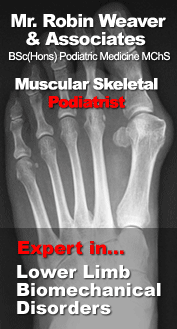|  Ingrown Toenails
Ingrown Toenails
 Ingrown
toenails are one the more common foot problems
treated by a Podiatrist. They can be very painful, with people limiting
their activity to keep off their sore feet. Ingrown
toenails are one the more common foot problems
treated by a Podiatrist. They can be very painful, with people limiting
their activity to keep off their sore feet.
Ingrown toenails are caused by impingement of the skin along
the margins of the nail by the nail plate. Some ingrown toenails
are chronic, leading to repeated episodes of pain and infection.
Pain can be present without infection, and occasionally
infection is present without pain. The usual signs of infection
include: redness (erythema), swelling (oedema), increased warmth
(calor), and pain.
Symptoms
- Pain along the margin(s) of the toenail
- Aggravated by wearing shoes, particularly those with narrow
toes.
- In growing nails may be sensitive to any pressure, even
the weight of bed linen can be very uncomfortable
- There may be signs of infection.
- There may be drainage of pus, or a watery discharge tinged
with blood.
Causes
- Abnormally shaped nail plate
- Improper trimming of toenails
- Tight fitting shoes which compress the toes together
- Socks or stockings that are too tight
- Other toenail deformities (i.e. excessively thick nail plate)
- Trauma to the nail plate or toe
What you can do
- Cut toenails straight across, and leave slightly longer
then the end of the toe
- Avoid tight-fitting foot wear
- If discomfort develops try soaking the foot in a basin
of very salty warm water two or three times a day. If you
are diabetic or have poor circulation the water should never
be more than 35 degrees Celsius or 95 degrees Fahrenheit.
Contact a state Registered Podiatrist or
Doctor immediately (qualifications for Chiropodists and
Podiatrists are very confusing- but state Registration is
the only qualification for Chiropodists and Podiatrists that
is recognised by the N.H.S.).
- An infected ingrown nail requires prompt professional
attention.
What the Podiatrist may do
- Trim the offending spike of nail to relieve the pressure.
Callous (dead skin) may have accumulated in the nail groove,
which needs to be removed. Routine ingrown toenail care
may need to be done periodically.
- Elevate the end of the nail plate to prevent impingement
on the soft tissues
- Surgically drain an infection
- Prescribe special soaks and/or antibiotics
- Surgically correct a chronic ingrown toenail
- Completely remove a deformed toenail so it will not grow
back.
- Remove the offending section of nail under local
anaesthetic and permanently destroy the specific section of
offending nail. This is procedure is known as phenolization-
Click on the link below to read a Times online article
about ingrowing nails and phenolization. www.timesonline
Complications of an ingrown toenail
- Infection, if present, may spread to the foot and leg,
or into the blood stream causing septicaemia and other life-threatening complications
- Loss of nail plate from infection or inflammation of the
nail bed.
- Chronic ingrowing nails can cause deformity of the nail
plate and/or surrounding soft tissues.
- A small benign tumour called a granuloma can form along
the nail margin.
- Diabetics and those with poor circulation to the feet
must never attempt to treat an ingrown toenail at home,
consult a Podiatrist or doctor
immediately.
|
...............................
 top
of page
top
of page
 ............................
............................ |

